In the first days of a baby's life, a newborn's skin may suddenly become covered with small pimples. These pimples can have different appearances - they can be red, white, they can cover certain areas of the skin, they can appear on the face, or on the whole body. In order not to puzzle over why pimples appeared on the face of a newborn, you need to know about the most common causes of their appearance, and, depending on the cause, select treatment. In general, there are acne that require treatment, and there are those that go away on their own.
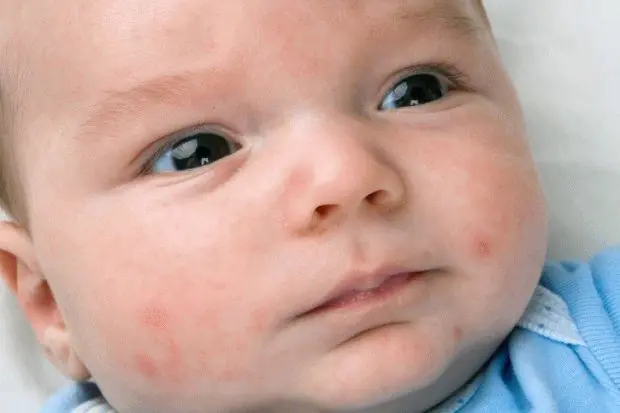
Causes of pimples
White pimples
- Newborn acne
An excess of maternal hormones in the child’s body.
After birth, the child’s body is saturated with maternal hormones, which affect the condition of the skin, because of this, children may develop a rash (ghormonal acne). This phenomenon has a scientific name - neonatal acne. Most often the face area is affected, less often other parts of the body. Acne does not require treatment, the only thing necessary is to keep your skin dry and clean. Acne is not contagious and is not a sign of poor hygiene. The main sign of acne is localization in the face, neck and scalp.
Excessive activity of the sebaceous glands.
Immediately after birth, the glands are activated, which is where pimples appear on the baby’s face. These pimples have the appearance of acne that cover large areas of the skin. The rash usually appears a week after birth and lasts about a month. There is no need to worry if the pimples on the face do not cause discomfort to the newborn baby - they do not itch, do not fester or become inflamed.
What pimples look like - they look like accumulations of pus under the skin of a whitish-yellow color (the base is red, the tip is white).
Video to watch:
- Milia
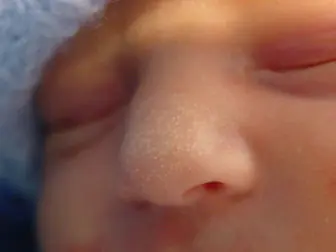
Small white pimples on the face of a newborn (white dots the size of a pinhead) are milia, an accumulation of secretions in the sebaceous glands (blockage of the sebaceous ducts). They go away on their own and cannot be squeezed out. clean with cotton swabs, treat with alcohol solutions, because You can get an infection and thereby cause an inflammatory process.
Red pimples
- Allergy
A common cause of red pimples is an allergic reaction to a product eaten by the mother. (through breast milk, the baby receives not only nutrients, but also allergens. Read about the nutrition of a nursing mother), or the formula that is fed to a newborn. To prevent allergies, a nursing mother should keep a diary in which she will write down everything she has eaten and the time when she ate this or that product. Typically, 18 hours after consuming the allergen, pimples may appear on the newborn's cheeks (and sometimes all over the body). In this case, the product is removed, and if the cause of the allergy is the mixture, then it should be replaced with another.
Allergies can also be caused by washing powder that is used to wash your baby’s clothes. Remember that a child’s skin is very delicate, so baby clothes should only be washed with powder or gel that is marked “hypoallergenic.” Allergies can also be caused by animal fur, flowering plants and other external irritants.
The allergy manifests itself in the form of red spots with small rashes and crusts that peel off.
If red spots (pimples) appear on the newborn's face, you should consult a doctor. Allergies require treatment.
Video to watch:
- Prickly heat
Clothes that are too hot, the air temperature in the child’s room is high, excessive "wrapping" - all this leads to the fact that the child begins to sweat. Skin that is constantly in a state of moisture becomes covered with acne. Acne first appears in the neck area, then it can spread to the face. To avoid the appearance of prickly heat, you need to maintain a constant air temperature in the room where the newborn is located - 18 - 22 degrees Celsius. It is advisable to dress the child only in clothes made from natural fabrics, according to the weather, and not to overheat.
- Dysbacteriosis
This is another reason for the appearance of pimples in newborns. Look at the symptoms and causes of dysbiosis.
To treat or not to treat
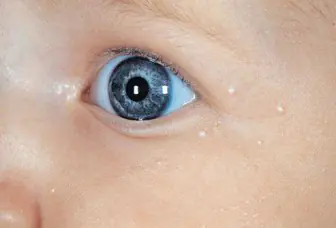
In most cases, the small white pimples (hormonal breakouts) go away on their own, so mom just needs to be patient. By about 2 months, most babies can already boast of soft, smooth skin without any acne.
Never squeeze pimples; this can seriously damage the top layers of the skin, cause infection and leave scars.
All doctors advise that if a rash or pimples appear, you need to consult a specialist; only a specialist can make the correct diagnosis.
Can:
If you still want to alleviate the condition of your baby’s skin, the simplest and most proven method is:
- Wash your child with boiled water 2 - 3 times a day;
- bathe the child in a weak solution of potassium permanganate;
- or bathe your baby in a series (bathing in various herbal decoctions). Sequential baths gently care for baby skin. Before daily bathing, add a brewed series to the bath (a large cup per bath) and bathe the child as usual;
- wipe the face and affected areas of the skin with a decoction of string or chamomile;
- It is necessary to ensure proper skin care (link to article below).
It is forbidden:
Do not use fucorcin, potassium permanganate or brilliant green for treatment, do not use alcohol-containing lotions or solutions, as these products will not cure acne and can only harm the baby’s health. No need to use: fatty oils and ointments, powder, calendula tincture, hormonal ointments, lactic acid bacteria or adsorbents (smecta), antibiotics, antihistamines. We repeat - squeezing pimples is prohibited!
Prevention
Most pimples in newborns are not considered dangerous and by following simple rules you can prevent their occurrence:
- A nursing mother should monitor her diet (what not to eat);
- For IV, monitor the reaction to the mixture;
- Proper hygiene and child care is necessary;
- Give your child air baths;
- Wash baby clothes with special powders.
If any acne or rash appears, you should immediately consult a doctor. The diagnosis should only be made by a specialist. There are a huge number of varieties of rashes that only a doctor can recognize.
Often, for severe and long-lasting acne, doctors prescribe medications such as Panthenol, Bepanten, Zinc ointment.
On the topic of skin problems:
Video: acne / allergies
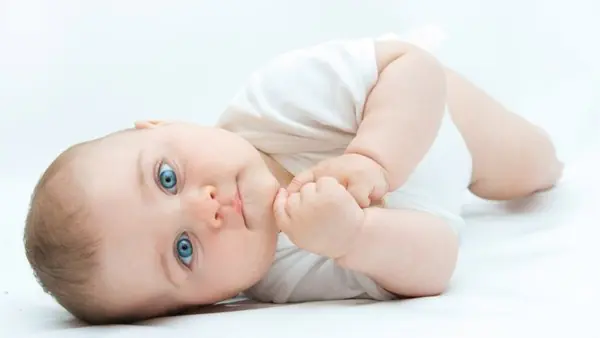
If a rash is detected in a baby, this fact cannot be ignored. Calmly find out the origin of the rash and relieve the baby from this discomfort.
Causes of pimples in babies
The cause of the rash can be not only external irritants, but also the growing up and development of the child. If the baby is about two to three weeks old, and pimples appear in the cheeks and neck, this indicates the beginning of the formation of hormonal levels. As a rule, the rash goes away on its own by three months of life. The peculiarity is that the pimples have a constant red color, sometimes with a whitish center.
Pay attention to the nutrition of a nursing mother. If, after eating certain foods, the redness in the cheek area becomes noticeably brighter, this indicates the presence of an allergy. Eliminate an inappropriate product from the diet; usually a small child reacts with a rash to the following irritants: citrus fruits, sweets, and sometimes cow’s milk.
You can avoid acne by following a diet for a nursing mother. Give your newborn air baths several times a day. Wash children's underwear separately from adults, using special detergents.
If the appearance of acne is accompanied by colic, anxiety, and stool disturbances, this may be a signal of intestinal dysbiosis. Take an extended stool test. Discuss your results with your pediatrician. If abnormalities are detected, the child will be prescribed the necessary medications to restore the microflora.
Sometimes acne on the face can indicate the beginning of the development of a disease. Don't diagnose yourself. Contact your local pediatrician for advice.
Climate change can also trigger acne. The baby does not need treatment, since the rash disappears after several days of adaptation and does not require special attention.
A room that is too warm or newborns are dressed too warmly can also cause rashes - prickly heat develops. Typically, pimples begin to appear on the baby's neck and then move up to the face. You can tell that a child is too hot by the fact that his face turns red. Don't overheat your baby. When dressing your baby, use a simple scheme: “clothes for yourself + 1”. This means that a child needs one more thing than an adult. For example, you are wearing a T-shirt, the baby is wearing a T-shirt and a sweater.
Measures to treat rashes
Having found out the cause of the rashes, begin proper care for them. Twice a day, wipe the newborn’s face with a cotton swab dipped in warm boiled water. When bathing your baby in the bath, add a little potassium permanganate to the water. The water should be pale pink. This will help dry out the resulting pustules. You can use chamomile and string. Do not squeeze pimples under any circumstances, as this can lead to infection in open wounds. Also, to treat redness, do not use fatty oils, antihistamines, hormonal ointments, or powder.
Young mothers are often worried about the appearance of a rash on the body of their newborn. The first thoughts that come to my mother at this moment are: this is an infection.
The skin is truly a mirror of the baby’s health; in addition, it performs a protective function and is an organ of excretion and thermoregulation. Many processes on a baby’s skin can be a sign of a disease. You should know that there are some physiological processes that show the immaturity of the skin.
In the first month of a newborn's life, a rash may appear on his body.
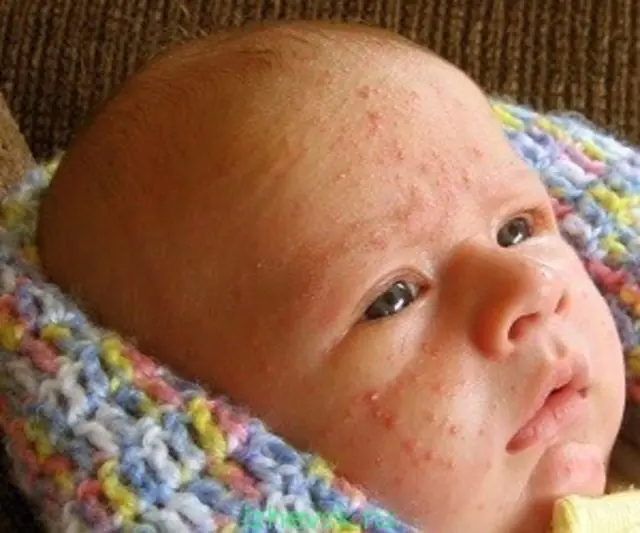
In the first days of a baby's life, a newborn's skin may suddenly become covered with small pimples.
What causes acne in a newborn?
- Mom's diet disorder. The appearance of pimples on a baby’s cheeks may indicate an intestinal reaction to a particular food product.
- Synthetic clothing, hygiene products for bathing - all this causes allergies and manifests itself in a rash. Allergic reactions are caused by plants, insects, and animal fur.
- Failure to comply with skin care and hygiene rules.
- Immaturity of the sebaceous and sweat glands.
- Sexual crisis in a newborn is a physiological process and is associated with the entry into his body of a large amount of maternal hormones. Therefore, so-called newborn acne appears on the skin - these are white pimples on the cheeks, neck and even scalp.
- Dysbacteriosis is another condition of the gastrointestinal tract, which causes acne to appear on the body.
- In a newborn, a rash on the cheeks may occur due to the immaturity of the thermoregulatory function of the skin after prolonged exposure to cold air. And also during climate change as a reaction to physiological stress.
- The last reason why a child develops pimples on his face and body is infectious diseases. These include chickenpox, rubella, and scarlet fever.
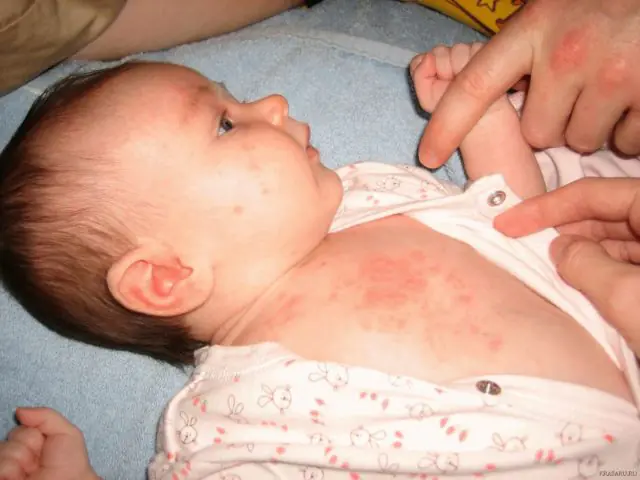
After birth, the child’s body is saturated with maternal hormones, which affect the condition of the skin, because of this, children may develop a rash (hormonal acne)
What rashes occur on the face and body of an infant?
White pimples in a newborn appear on the third day of life, sometimes appearing at 2 weeks. More often they appear as a manifestation of a sexual crisis due to excess supply of hormones. The base of these eruptive elements is red, and pus accumulates at their top.
White pimples in a newborn on the T-zone occur due to the immaturity of the sebaceous glands. This rash is called milia. Essentially, there is a blockage of the sebaceous ducts, which goes away on its own after two weeks.
Yellow acne that is surrounded by a red ring is erythema toxicum. In a baby, pimples on the face of this nature are physiological and go away on their own in 1–2 weeks.
Red pimples on a child’s cheeks are inflammatory formations that can be a manifestation of an allergy or infection. A red blister on the skin with a cloudy liquid inside is a sign of a viral skin disease.
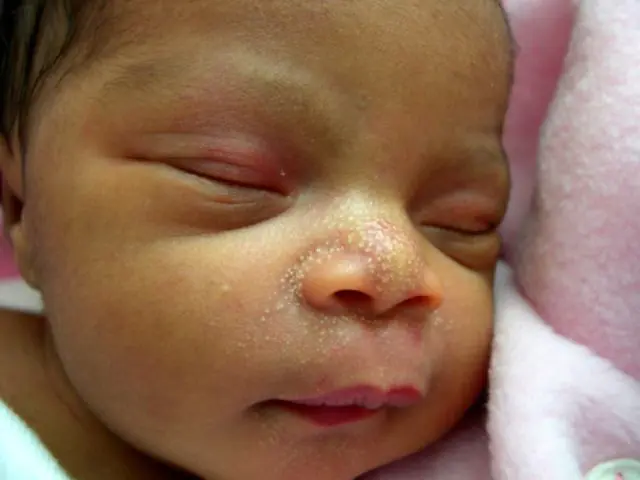
Immediately after birth, the glands are activated, which is where pimples appear on the baby’s face.
Large red rashes located on the cheeks, stomach and buttocks, as well as red cheeks in infants, are signs of an allergy. These pimples cause him great concern because they are accompanied by unpleasant sensations: burning, itching.
Large pustular formations in a baby are signs of a bacterial infection or complications due to lack of care for the baby’s skin.
Miliaria is an inflammation of the skin that occurs with excessive sweating, most often in a month-old baby. Occurs as a result of increased body temperature, the environment, and poor hygiene. In this case, inflammation should be expected in the area of natural folds of the body, the area under the diaper. To avoid this condition, you need to ensure that the baby does not overheat and give preference to clothes made from natural materials.
Watery pimples can be a manifestation of diaper rash and appear in areas of prolonged friction. In the absence of proper care, ulcers appear at the affected sites.
A watery pimple on the cheek may be a manifestation of chickenpox or herpes. The difference is that with smallpox, the rash elements go through the entire development cycle from spots to vesicles, so the rash is polymorphic.
White pimples in the mouth can be signs of stomatitis, candidiasis; isolated white spots are one of the symptoms of measles.
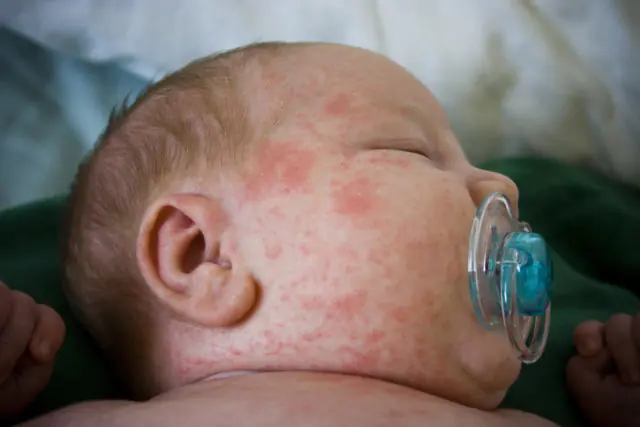
A common cause of red pimples is an allergic reaction to a product eaten by the mother.
Childhood infections
What causes acne in young children? Most often they are caused by infectious diseases. Childhood infections include measles, rubella, scarlet fever, enterovirus, and chickenpox.
Symptoms of measles are high fever, runny nose, cough, conjunctival swelling, red throat. A red rash in the mouth followed by white spots. After a day, the rash spreads to the face, neck, arms and legs. It differs from other types of rash in that the elements on the skin tend to merge.
Rubella in the first days is manifested by enlarged cervical lymph nodes, inflammation of the throat, and conjunctivitis. After 2 days, a rash appears, it starts from the face and after a while spreads to the whole body.
Chickenpox occurs without warning in young children. Most often, the rash appears en masse, but first small pimples appear on the child’s cheeks and then they quickly spread to the body. After chickenpox, rough scars may form.
Scarlet fever is manifested by high fever, refusal to eat, headache, small pimples appear on the cheeks, groin area, and sides of the body. Scarlet fever has a number of characteristic manifestations that distinguish it from other diseases. These include sore throat, “raspberry” tongue, peeling on the palms and soles.
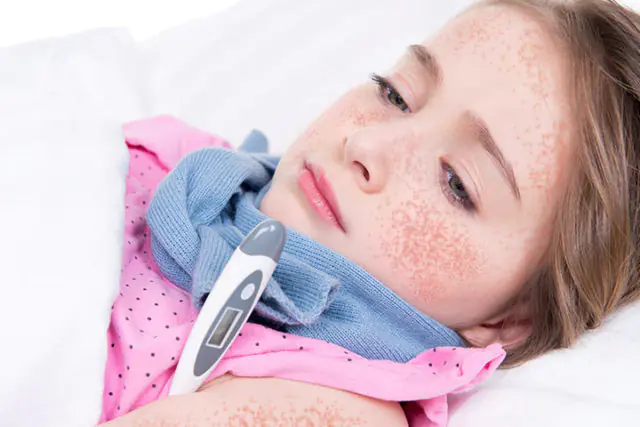
Sick children are usually agitated and do not take instructions from their parents well.
Enterovirus infection resembles a cold in the clinic. On the second day of the disease, blisters and pink spots appear on the skin. They are typically located on the face, arm, and leg.
How to treat various rashes?
Not all cheek rashes in newborns require any intervention:
- In a newborn, pimples of hormonal origin, milia do not require treatment, go away on their own after two weeks.
- If the cause of a rash on a child’s cheeks is an allergy, it is necessary to analyze the diet of both him and his mother during the day: whether new foods were introduced into complementary foods, whether the mother consumed food allergens. It is advisable for mom to keep a food diary. Any other things that cause an allergic reaction must be removed.
- In a child, pimples on the body in the form of prickly heat require access to air to the areas of inflammation. It is advisable not to use diapers and less synthetic clothing. Hygienic baths with chamomile decoction will relieve inflammation. Then blot the liquid with a soft towel and let the skin dry. In a child, pimples due to prickly heat after hygiene procedures are sprinkled with a thin layer of powder or talcum powder.
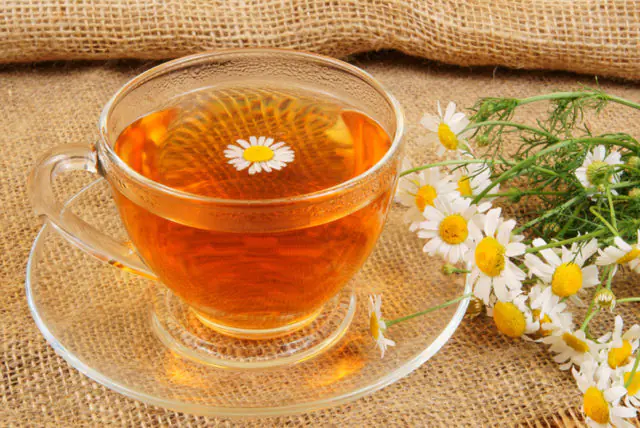
Traditional healers recommend treating pimples on the face of newborns with a decoction of herbs - Pimples on a child's face caused by infection require the help of a doctor.
- Red cheeks in a baby due to intestinal dysfunction require the prescription of probiotics and a diet for the mother if the baby is breastfed, and the selection of a formula when the baby is bottle-fed.
What to do if the rash does not go away? Pimples on the face tend to spread throughout the body. Typically, a physiological rash goes away on its own. Other rashes disappear within a month. If acne in newborns does not go away, this indicates a bacterial infection. If the number of loose elements increases, the temperature rises, and the general condition worsens - this indicates childhood infectious diseases.
There are several pharmaceutical drugs that are used for rashes in infants:
- “Fenistil” is an anti-allergy drug, one of the first-line antihistamines, it relieves itching, swelling, and reduces the amount of rash. Suitable for children from 1 month. Available for indoor and outdoor use.
- "Polysorb" - used from birth. Removes toxic and allergic substances from the body. Helps treat pimples on the cheeks of a newborn.
- "Bepanten" - available in the form of ointment and cream, the composition includes "Panthenol". This drug accelerates wound healing and prevents the development of infections. Used for prickly heat and diaper rash.
- Enterosgel is another drug from the group of sorbents that absorbs toxic substances. In the intestines, it suppresses the growth of pathogenic microorganisms without affecting the microflora.
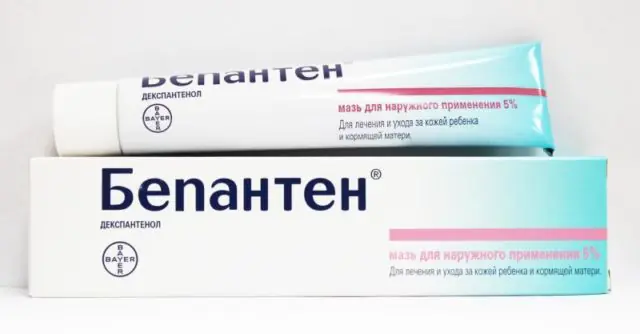
Pediatricians recommend that if acne is detected in infants, go to the clinic to make the correct diagnosis, on which treatment will depend.
Contraindications for the treatment of acne in infants:
- use of acne products for adults;
- squeezing out bulk elements.
Doctors' recommendations for caring for a newborn
When rashes appear on the skin of a baby, you should adhere to certain rules.
The baby is bathed daily with the addition of a decoction of herbs. After each bowel movement, you should wash your baby.
Mom must stick to a diet. If there is a strong desire to eat something, first try a small piece, and when the newborn does not react within 24 hours, the dish can be consumed. The same thing applies to the introduction of new products into complementary foods. If the baby is bottle-fed, you need to monitor his reaction to the formula.
Bed linen and clothing should be made from natural fabrics. Special children's powders should be used to wash clothes.
If necessary, acne on a child's face and body is treated with an ointment based on Panthenol. In the newborn's room the temperature should be no lower than 18 degrees and no higher than 23. At the same time, it is necessary to maintain an optimal level of air humidity; dry air has an adverse effect. The baby needs to be given extra water, even if he is breastfed. Before going outside during the cold season, exposed parts of the body are lubricated with a special cream. When planning a move or long trips, it is worth discussing this with your pediatrician.




